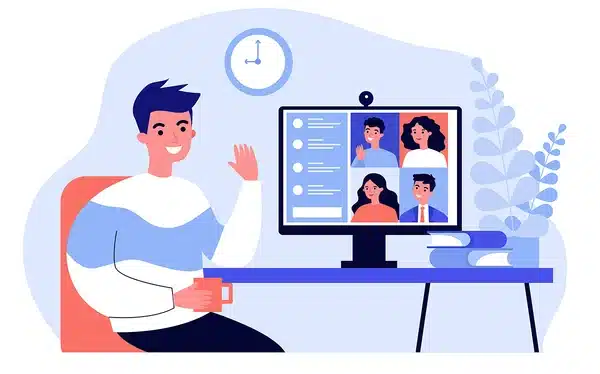Imagine this scenario. You work in the Marketing department of a small professional association. Your IT department migrated everyone to Office 365 a few weeks ago. You open your computer to a series of email notifications that you have chat messages waiting for you in some tool called Microsoft Teams from one of your colleagues in the Marketing department regarding the email campaign you are both working on. However, as you start trying to figure out how to reply to your colleague via Teams chat, your manager is simultaneously sending you chat messages via Skype for Business to find out the status of the same email campaign. While you prepare to respond to your manager, one of the designers in the Creative Services team shares a mockup graphic she created via her personal Dropbox account. While you glance at the mockup and start to suggest a few changes, you receive a Slack invite from the Database Manager asking you to post your list request to a Trello board so he can get started developing the query. You login to your Trello account with your personal email address and start entering the Trello Card, when you are interrupted with a notification via your phone’s Google Drive app that your Marketing colleague’s email copy is ready for review on Google Docs. You look at the email copy on your phone but realize that your colleague must have been working from the wrong file. You comment on the Google Doc with a note that the correct file is on your personal OneDrive and share a link so he can find it.
Does this scenario sound at all familiar? You can rest assured that you are by no means alone. As cloud-based digital tools have proliferated over the past decade, the challenge has become less about getting the digital collaboration tools up and running and more about how to use those tools effectively.
Welcome to the Digital Workplace
The concept of a “digital workplace” has emerged as work has moved from the physical realm into digital spaces. As defined by Chris Tubb, “the digital workplace is the collection of all of the digital tools provided by an organization to allow its employees to do their jobs.” Designing a digital workplace that helps your organization work more effectively is critical to its success. The good news is that building a successful digital workplace isn’t nearly as difficult or expensive as renovating your physical office space.
What does a successful digital workplace look like?
- Staff store files and information according to consistent guidelines
- Staff use consistent digital communication channels to collaborate across the office
- Staff are aware of all the productivity tools available to them
- Staff have the training to complete a defined set of basic digital workplace competencies
What follows is a framework for designing an effective digital workplace.
Steering Team
To design your digital workplace, you need input from a variety of perspectives in your organization. If you don’t already have an IT Steering or similar team, you can create an ad hoc digital workplace steering team that will be charged with developing your digital workplace framework. This group’s charter will be to gather input from colleagues and draft the standards and guidelines for staff to follow when they communicate and collaborate. Like any governance initiative, the steering team needs to be vested with authority to develop recommendations that can be approved by senior leadership.
Strategy
Every digital workplace is different. An organization with 100 staff around the globe will use its digital tools in a very different way than an organization of five staff that show up at a physical office from 9-5 every day. You need to know what you want to accomplish with your digital workplace in order to build it in support of those goals. It’s important to define your objectives, tactics, and measures so you have a guide for all the standards you come up with later in the process.
File Storage Standards
Documents, spreadsheets, presentations, graphics, videos, and web pages are a critical currency in most modern organizations. Now that storage is cheap and there are a wide range of cloud-based file storage options available, the challenge is less about cost and more about standardization. It is critical that your digital workplace steering team develop simple guidelines for staff to make them aware of all the official file storage repositories available to staff, as well as the standards for when to use them.
Communication and Collaboration Standards
Most organizations have unspoken norms that define how staff are expected to communicate and collaborate with one another, but it’s rare that an organization actually documents those norms. Standards must be established that describe the official channels that are available, as well as the expectations for using them. For example, Teams chat may be the primary communication channel for synchronous communication between staff, while Zoom may be the primary channel for web meetings.
Competencies
After you’ve defined file storage and internal communication and collaboration standards, you should have a list of the official tools that your organization is using for its digital workplace. You now need to make sure that all staff have a shared understanding for how to effectively use those digital workplace tools in the course of their work. Focus on defining a short list of specific competencies that are required for every person to be a productive team member. Once this is documented, you can target your internal training activities to reinforce those competencies.
Roles & Responsibilities
The last step for your digital workplace steering team is to define the roles and responsibilities with respect to your digital workplace. A simple way to do this is to create a RACI matrix that outlines the following:
- Responsible = Who does the activity.
- Accountable = Who can make the decision.
- Consulted = Whose input is sought before making a decision.
- Informed = Who is notified of the decision/action after it is made.
No matter how you arrange the roles and responsibilities, it’s important to document what they are to avoid confusion. The digital workplace steering team must make sure to clarify its own responsibility and accountability for maintaining the strategy and standards of the digital workplace.
A Better Way to Work
Now let’s get back to the scenario we started with. This time, your organization has standards in place for file storage and internal communication and collaboration. All staff understand what they are expected to know, and training has been offered to fulfill those defined competencies. When you get to the office, you open Microsoft Teams and notice a new Email Marketing channel message from your Marketing colleague. You efficiently respond to her question in the Email Marketing channel and your manager (who is monitoring the same channel) gives your message a “thumbs up” reaction to acknowledge that she knows the status of the campaign. In the same Email Marketing channel, the designer from the Creative Services team posts a message mentioning you by name to view the mockup graphic she designed on SharePoint Online. You review the mockup and reply with your feedback. The Database Manager, who has been monitoring the Email Marketing channel and Microsoft Planner task board for the email campaign, marks the list request task as complete and posts a message that he has the query ready for you when the campaign is ready for delivery. Likewise, your Marketing colleague posts a link to the Email Marketing channel that the copy is ready for your review on SharePoint Online. You easily open the file within Teams, make your suggested edits and confirm that your review is complete.
Hopefully you now recognize that a better way to work is within reach. The most important piece of advice is to remember that your guidelines should be simple enough that you could share them with a new staff person during her first week. You’ll also want to make sure to re-convene your digital workplace steering team at least once a year to revisit and refresh your strategy and standards to account for new tools and capabilities within existing tools.
Ready for DelCor to help facilitate the process for you?

Talk to Our Experts
Looking for more information? Have questions? We’re here to help!
Drop us a line, and we’ll get in touch right away.

